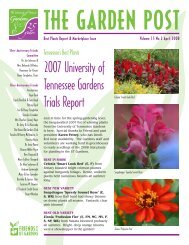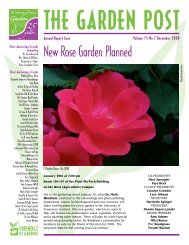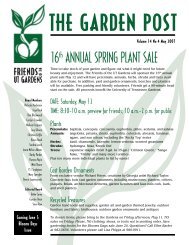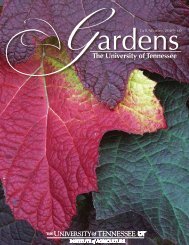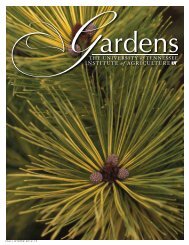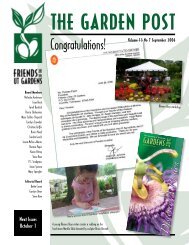October - UT Gardens - The University of Tennessee
October - UT Gardens - The University of Tennessee
October - UT Gardens - The University of Tennessee
You also want an ePaper? Increase the reach of your titles
YUMPU automatically turns print PDFs into web optimized ePapers that Google loves.
Friends courses at <strong>UT</strong><br />
Dig and Divide<br />
How <strong>of</strong>ten does someone invite you to come and<br />
learn how to dig treasures out <strong>of</strong> the<br />
yard? This is your opportunity to dig in the <strong>UT</strong><br />
<strong>Gardens</strong> and take home a load <strong>of</strong> plants<br />
for your own use, too. We will learn how to divide<br />
plants in the perennial beds throughout the<br />
<strong>Gardens</strong>, replant one section <strong>of</strong> a plant, and put<br />
the remainder in the course pool for participants to<br />
select from when the digging is completed. Tools<br />
will be provided, but if you have favorite digging<br />
tools and hand pruners, bring them along. Also,<br />
dress comfortably and be prepared to get dirty and<br />
have a good time.<br />
Date: Saturday, Oct. 13, l0 a.m.-12 noon<br />
Location: Friendship Plaza <strong>of</strong> the <strong>University</strong> <strong>of</strong><br />
<strong>Tennessee</strong> <strong>Gardens</strong>, Agriculture Campus<br />
Instructors: <strong>UT</strong> <strong>Gardens</strong> Staff assisted by master<br />
gardeners from the Friends <strong>of</strong> the <strong>University</strong> <strong>of</strong><br />
<strong>Tennessee</strong> <strong>Gardens</strong><br />
Course # 281620<br />
Fee: $49<br />
Space is strictly limited for this class.<br />
Registration deadline is Oct. 5.<br />
Plants Alive! Keeping <strong>Gardens</strong> and Containers<br />
Awake in Winter<br />
Fight those winter blues and blahs. Learn how to<br />
maintain winter interest in the garden, including<br />
a review <strong>of</strong> plant material to use for winter and<br />
early spring containers. Also, design strategies for<br />
selecting plant material as well as techniques for<br />
grooming the winter garden will be discussed and<br />
demonstrated.<br />
Date: Saturday, Oct. 20, l0 a.m.-12 noon<br />
Location: Friendship Plaza <strong>of</strong> the <strong>University</strong> <strong>of</strong><br />
<strong>Tennessee</strong> <strong>Gardens</strong>, Agriculture Campus<br />
Instructor: Karen Petrey. With degrees in ornamental<br />
horticulture and plant and soil science from <strong>UT</strong>, Karen<br />
has extensive experience as a garden designer in East<br />
<strong>Tennessee</strong>. She is also a past president <strong>of</strong> the Friends.<br />
Course #: 281605<br />
Fee: $39<br />
Beyond Dogwoods and Azaleas – Less Common<br />
Trees and Shrubs for the Home Garden<br />
Searching for distinctive trees and shrubs beyond<br />
the usual spring pretties? Explore some <strong>of</strong> the less<br />
commonly used woody plants suitable for our area.<br />
After a slide presentation, we will stroll through the<br />
<strong>University</strong> <strong>Gardens</strong> to see some <strong>of</strong> these unusual<br />
specimens first hand.<br />
Date: Saturday, Nov. 3, l0 a.m.-12 noon<br />
Location: Room 128 in <strong>UT</strong> Ellington Plant Sciences<br />
Building on the Agriculture Campus<br />
Instructor: Nancy Rennie A graduate <strong>of</strong> the <strong>UT</strong> ornamental<br />
horticulture and landscape design program,<br />
Nancy has extensive experience as a consultant and<br />
garden designer in East <strong>Tennessee</strong>.<br />
Course #: 281606<br />
Fee: $39<br />
Holiday Wreaths with Greenery from the <strong>Gardens</strong><br />
<strong>The</strong>re is no substitute for fresh greenery and woody<br />
plant material plucked directly from the wide selection<br />
at the <strong>University</strong> <strong>Gardens</strong> under the guidance<br />
<strong>of</strong> a master designer. Course members will<br />
have the option <strong>of</strong> constructing a wreath or centerpiece<br />
arrangement. <strong>The</strong>re will also be a demonstration<br />
<strong>of</strong> how to fashion a “kissing ball.” Participants<br />
are encouraged to bring material from their own<br />
gardens to use and to share.<br />
If you plan to make a centerpiece and have a<br />
special container you want to use, please bring it.<br />
Also, bring your own hand pruners. All other materials<br />
will be furnished, and a $10 materials fee is<br />
due to the instructor at the class.<br />
Date: Saturday, Dec. 8, 10 a.m.-12 noon<br />
Location: <strong>UT</strong> Greenhouse 11, Agriculture Campus<br />
Instructor: Nancy Robinson<br />
Course #: 281600<br />
Fee: $39<br />
Space is strictly limited for this class.<br />
Registration deadline is Dec. 1.<br />
<strong>The</strong> Friends <strong>of</strong>fer educational programs through <strong>UT</strong><br />
Outreach & Continuing Education Pr<strong>of</strong>essional<br />
& Personal Development. Call 865-974-0150 to<br />
register or order a catalog, or see www.outreach.<br />
utk.edu/ppd to register or for additional details.<br />
Nyssa sylvatica<br />
Black Tupelo, Black Gum or Sour Gum<br />
By Andrew Pulte<br />
Around the year 1735 the first member <strong>of</strong> the<br />
genus Nyssa was described and given the name<br />
Nyssa aquatica. Nyssa is a derivation <strong>of</strong> Nysa,<br />
the mythological water nymph. Later (around<br />
1750) this plant was discovered to be related to<br />
one <strong>of</strong> the Eastern Seaboard’s most beloved native<br />
trees: Nyssa sylvatica or Black Gum. <strong>The</strong> scientific<br />
name “sylvatica” means “<strong>of</strong> woods,” which<br />
by all accounts would make Black Gum the water<br />
nymph <strong>of</strong> the woods. This makes sense, because<br />
you <strong>of</strong>ten find this tree along stream banks<br />
throughout the eastern half <strong>of</strong> the U.S. However,<br />
it’s not isolated to stream beds; it’s also quite<br />
ubiquitous in the Southeast in both lowland and<br />
upland areas. In the wild you will find Black Gum<br />
in large groups as well as mixed with other hardwood<br />
trees. <strong>The</strong> common name Black Gum is<br />
somewhat <strong>of</strong> a misnomer, because the tree is not<br />
known to produce latex or gum <strong>of</strong> any kind.<br />
<strong>The</strong> wood <strong>of</strong> Nyssa has been used for centuries<br />
for implement handles, skid poles and even floors.<br />
Black Gum could possibly be one <strong>of</strong> our most<br />
underused native trees. It is adaptable to both wet<br />
and dry sites and is relatively immune to almost all<br />
insects and disease.<br />
This tree is also interesting during all four seasons.<br />
In spring a beautiful flush <strong>of</strong> shiny green leaves<br />
appears with s<strong>of</strong>t greenish yellow flowers. This<br />
is followed by a late summer crop <strong>of</strong> small blue<br />
and red berries that are quickly eaten by wildlife<br />
as they ripen in late September. Fall is when this<br />
tree really comes into its own, as its leaves show<br />
their charm in shades <strong>of</strong> florescent yellow, orange,<br />
scarlet and deep purple. Black Gum is by far one<br />
<strong>of</strong> the most consistent in its fall display and never<br />
seems to disappoint those looking for a tree with<br />
fall personality. When the brilliance <strong>of</strong> fall is past,<br />
the gray-brown, broken and thick irregular bark<br />
Nyssa sylvatica, or Black Gum, is interesting in the landscape during all seasons,<br />
but fall is when this tree comes into its own. Photo courtesy <strong>of</strong> Michigan<br />
State <strong>University</strong>.<br />
stands out and complements the different forms <strong>of</strong><br />
this tree, which can range from pyramidal in youth<br />
to oval at maturity.<br />
Nyssa sylvatica is a great size tree for many<br />
urban yards. It matures to between 30 feet and<br />
50 feet high and spreading around 20 feet or 25<br />
feet. Typically only the straight species <strong>of</strong> this<br />
tree is planted; however, some noteworthy cultivars<br />
can be found in the nursery trade. <strong>The</strong> <strong>UT</strong><br />
<strong>Gardens</strong> proudly displays the common species <strong>of</strong><br />
Nyssa sylvatica along with Nyssa sylvatica<br />
‘Zydeco Twist’ a new contorted variety, and Nyssa<br />
sylvatica ‘Dirr’, a variety chosen by plantsman<br />
Michael Dirr from the <strong>University</strong> <strong>of</strong> Georgia. You<br />
may also want to look out for the variety ‘Wildfire’<br />
chosen specifically for fall color and ‘Autumn<br />
Cascades’ which has a graceful weeping habit.<br />
14 15



